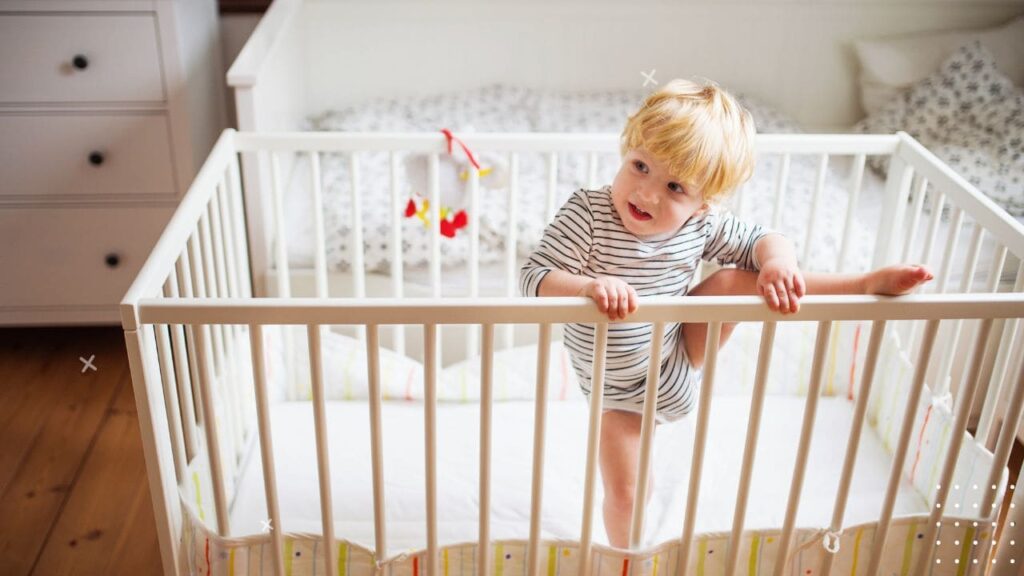Picture this: It’s 2 AM, and you’re jolted awake by the pitter-patter of tiny feet. Your heart races as you realize your little escape artist has once again conquered the crib bars. Sound familiar? You’re not alone in this nighttime adventure. When your toddler climbs out of crib, it can feel like you’re suddenly starring in your own suspense thriller – minus the popcorn and comfy couch.
But fear not, fellow sleep-deprived parents! We’re about to embark on a journey to reclaim those peaceful nights. In this guide, we’ll explore why your pint-sized Houdini is making great escapes and unlock 8 remarkable secrets to keep your toddler snug as a bug in their crib. So grab your favorite caffeinated beverage, and let’s dive in!
Understanding Why Toddlers Climb Out of Cribs
Before we jump into our arsenal of crib-climbing solutions, let’s take a moment to understand why your little one has suddenly developed a passion for nocturnal acrobatics. After all, knowing your opponent is half the battle, right?
Developmental Reasons
As your baby blossoms into a toddler, their world expands exponentially. They’re mastering new skills daily, and sometimes, that includes figuring out how to scale Mount Crib. Here’s what might be driving this newfound climbing obsession:
- Changing sleep needs: Your toddler’s sleep patterns are evolving. They might not need as much sleep as before, leaving them restless and ready to explore when they should be snoozing.
- Milestone practice: Remember how proud you were when your little one took their first steps? Well, they’re equally excited about their new climbing skills and want to practice – day and night!
- Self-soothing challenges: Some toddlers haven’t quite mastered the art of self-soothing. When they wake up, instead of settling back to sleep, they decide it’s time for a midnight adventure.

Environmental Factors
Sometimes, it’s not just what’s going on inside your toddler’s head, but what’s happening around them that triggers the great escape:
- Crib to bed transition: If you’ve been talking about moving to a big kid bed, your toddler might be trying to speed up the process.
- New sibling arrival: Nothing says “I’m not the baby anymore” quite like climbing out of the crib. It’s your toddler’s way of asserting their big kid status.
- Screen overload: Too much screen time, especially before bed, can overstimulate your toddler, making it harder for them to settle down and stay in their crib.
Physical and Emotional Factors
Let’s not forget that toddlers are little humans with big feelings and growing bodies:
- Sleep regression: Just when you thought you had this sleep thing figured out, sleep regressions hit. These can disrupt sleep patterns and lead to more nighttime wakings and escape attempts.
- Fear of the dark: As your toddler’s imagination develops, so might their fear of the dark or monsters under the bed. Climbing out might be their way of seeking comfort.
- Separation anxiety: Some toddlers experience a phase of increased separation anxiety, leading them to seek you out during the night.
- Teething pain: Those molars coming in? Teething discomfort can disrupt sleep and prompt your toddler to seek comfort outside the crib.
- Physical needs: Sometimes, the reason is as simple as needing a drink of water or a trip to the bathroom.
Other Influences
A few other factors that might contribute to your toddler’s escapades:
- Sugar overload: Too many sweets, especially close to bedtime, can lead to a sugar rush that makes sleep elusive.
- Potty training: If you’re in the midst of potty training, your toddler might be extra aware of their need to use the bathroom, prompting nighttime crib escapes.
- Nap changes: As nap needs change, it can affect nighttime sleep patterns, potentially leading to more night wakings and crib climbing.
Now that we’ve unraveled the mystery behind your toddler’s escape artist tendencies, let’s dive into those 8 remarkable secrets for peaceful nights!
The 8 Remarkable Secrets for Peaceful Nights
Secret #1: The Lowered Mattress Trick
When your toddler climbs out of crib, sometimes the simplest solution is the most effective. Enter the lowered mattress trick. By adjusting the height of the crib mattress, you can make it more challenging for your little climber to make their great escape.
Here’s how to implement this secret:
- Check your crib’s manual for guidance on adjusting the mattress height.
- Lower the mattress to the lowest setting possible.
- Ensure there’s at least 26 inches between the top of the mattress and the top of the crib rail.
- Remove any bumpers or toys that could be used as stepping stones.
Pros of this method include its simplicity and the fact that it doesn’t require any additional purchases. However, it’s worth noting that particularly tall or determined toddlers might still manage to climb out.
Remember, safety first! Always ensure that lowering the mattress doesn’t create any gaps where your toddler could get stuck.
Secret #2: The Backwards Pajama Technique
Get ready for a giggle-worthy solution that’s as effective as it is adorable. The backwards pajama technique involves putting your toddler’s zip-up pajamas on backward. This simple switch can make it trickier for little hands to unzip and wriggle out, potentially deterring crib escapes.
When selecting pajamas for this method:
- Choose zip-up styles without feet
- Opt for snug-fitting pajamas to prevent any safety hazards
- Consider pajamas with built-in mittens for extra climb-proofing
While this method can be highly effective, be prepared for some initial confusion or frustration from your toddler. Also, ensure the backwards pajamas don’t restrict movement too much – you want to prevent climbing, not comfort!
Secret #3: The Sleep Sack Solution
Sleep sacks are like cozy, wearable blankets that can be a game-changer when your toddler climbs out of crib. They provide warmth and comfort while limiting leg movement, making it more challenging for your little one to hoist themselves over the crib rail.
When choosing a sleep sack:
- Look for ones specifically designed for toddlers
- Choose a size that allows for movement but isn’t too loose
- Consider sleep sacks with foot openings for more mobile toddlers
- Opt for breathable fabrics to prevent overheating
Sleep sacks come in various styles, from lightweight for summer to fleece-lined for colder months. Some even come with snap-on sleeves for added versatility.
While sleep sacks can be incredibly effective, be prepared for a potential adjustment period. Some toddlers might initially resist the restricted movement.

Secret #4: The Crib Tent Approach
For particularly persistent climbers, a crib tent might be the solution you’ve been dreaming of. A crib tent is a mesh dome that fits over the top of the crib, creating a cozy, escape-proof sleep haven for your little one.
Here’s what you need to know about crib tents:
- They’re designed to fit most standard cribs
- Most come with easy installation instructions
- They provide excellent ventilation while preventing climbs
- Some models have a zip-up side for easy access
When using a crib tent, always follow the manufacturer’s instructions carefully. While they can be very effective, it’s crucial to ensure they’re installed correctly to prevent any safety hazards.
Pros of crib tents include their high effectiveness and the peace of mind they provide. However, some children might feel confined, and there’s always the possibility of your clever toddler figuring out the zipper.
Secret #5: The Strategic Room Makeover
Sometimes, the key to keeping your toddler in their crib lies in their surroundings. A strategic room makeover can eliminate temptations and create a sleep-friendly environment that encourages your little one to stay put.
Here’s how to toddler-proof the bedroom:
- Remove furniture near the crib that could serve as stepping stones
- Secure bookshelves and dressers to the wall to prevent tipping
- Use cordless window blinds to eliminate strangulation hazards
- Install childproof covers on electrical outlets
- Remove any toys or objects that might entice your toddler out of bed
Consider these sleep-promoting elements:
- Blackout curtains to create a dark, sleep-inducing environment
- A white noise machine to mask disruptive sounds
- A dim nightlight to alleviate fear of the dark
Remember, the goal is to create a safe, cozy space that promotes sleep rather than exploration. A clutter-free, calming environment can work wonders in keeping your toddler content in their crib.
Secret #6: The Positive Reinforcement Method
Never underestimate the power of praise and rewards when it comes to encouraging good sleep habits. The positive reinforcement method focuses on celebrating your toddler’s successes rather than punishing escapes.
Here’s how to implement this approach:
- Create a sticker chart to track nights spent in the crib
- Offer small rewards for consecutive nights without escapes
- Use verbal praise and excitement when your toddler stays in their crib
- Consider a special breakfast or activity for achieving sleep goals
The key is consistency and enthusiasm. Make staying in the crib seem like the most exciting thing your toddler could do!
Some reward ideas include:
- Extra storytime the next day
- A special outing to the park
- Choosing the family movie for movie night
- A small toy or book after a certain number of successful nights
Remember, the rewards don’t have to be big or costly. Your excitement and pride will be the biggest motivator for your toddler.
Secret #7: The Consistent Bedtime Boundary Setting
Consistency is king when it comes to toddler sleep habits. Setting clear, firm boundaries around bedtime can help your little one understand that nighttime is for sleeping, not for acrobatics.
Here’s how to establish and maintain bedtime boundaries:
- Create a consistent bedtime routine (bath, story, cuddles, etc.)
- Set a clear bedtime and stick to it every night
- Explain the rules clearly: “It’s time to sleep. You need to stay in your crib until morning.”
- If your toddler climbs out, calmly and quietly return them to the crib
- Avoid engaging in conversation or play during nighttime returns
For middle-of-the-night escapes:
- Keep interactions minimal and boring
- Use a phrase like “It’s still sleepy time” and return them to the crib
- Resist the urge to bring them into your bed (unless that’s part of your long-term plan)
Consistency is key here. It might take a few nights (or even weeks) of repeatedly returning your toddler to their crib, but stay strong! Your persistence will pay off.
Secret #8: The Gradual Transition to a Toddler Bed
Sometimes, the best way to keep your toddler from climbing out of the crib is to… well, get rid of the crib! If your little one is showing signs of readiness, transitioning to a toddler bed might be the solution you’ve been looking for.
Signs your toddler might be ready for a big kid bed:
- Consistently climbing out of the crib
- Height over 35 inches
- Showing interest in a big bed
- Asking for a bed like an older sibling’s
Here’s how to make the transition smooth:
- Talk about the move positively and build excitement
- Let your toddler help choose bedding or decorations for their new bed
- Start with naps in the new bed before transitioning nighttime sleep
- Use a bed rail to prevent falls
- Childproof the entire room, as your toddler will now have free reign
Remember, this transition often comes with a period of adjustment. Your toddler might initially get up more frequently or have trouble settling. Stay patient and consistent with your bedtime routine and rules.

Additional Strategies to Keep Your Toddler in Bed
While our 8 secrets form a solid foundation for peaceful nights, here are some additional strategies to reinforce good sleep habits:
- Establish a solid bedtime routine: A consistent routine signals to your toddler that it’s time to wind down. This could include a warm bath, storytime, and quiet cuddles.
- Leave the room before sleep: Gradually work towards leaving the room while your toddler is still awake but drowsy. This helps them learn to fall asleep independently.
- Consider sleep training methods: Techniques like the chair method or bedtime fading can be effective for persistent sleep issues.
- Offer comfort items: A special stuffed animal or blanket can provide comfort and security during the night.
- Adjust nap schedule: Ensure daytime naps aren’t interfering with nighttime sleep. Most toddlers need 1-3 hours of daytime sleep.
- Limit liquids before bed: Reduce drinks in the hour before bedtime to minimize nighttime bathroom trips.
- Avoid screens before bedtime: The blue light from screens can interfere with the production of sleep hormones. Try to avoid screens for at least an hour before bed.
Nap Time Considerations
Naps play a crucial role in your toddler’s sleep patterns. Here’s a quick guide to toddler naps:
| Age | Number of Naps | Total Nap Duration |
|---|---|---|
| 12-18 months | 1-2 naps | 2-3 hours |
| 18-24 months | 1 nap | 1.5-3 hours |
| 2-3 years | 1 nap | 1-2 hours |
| 3-5 years | 0-1 nap | 0-2.5 hours |
Remember, every child is different. Some toddlers may drop naps earlier or later than others. The key is to watch your child’s behavior and adjust accordingly.
If nap time is interfering with nighttime sleep:
- Try shortening the nap
- Move nap time earlier in the day
- If your toddler is over 3, consider phasing out naps altogether
When to Seek Professional Help
While it’s normal for toddlers to go through sleep challenges, sometimes professional help can provide valuable insights and solutions. Consider consulting a pediatric sleep specialist if:
- Your toddler’s sleep issues are severely impacting family life
- You’ve consistently tried various methods without success
- Your toddler seems excessively tired during the day
- There are signs of sleep apnea (loud snoring, pauses in breathing during sleep)
- You’re concerned about your toddler’s overall development
A sleep consultation typically involves:
- A thorough review of your toddler’s sleep history
- Discussion of current sleep habits and routines
- Examination of your toddler’s sleep environment
- Development of a personalized sleep plan
- Follow-up support as you implement changes
Remember, seeking help isn’t a sign of failure – it’s a proactive step towards better sleep for the whole family!
Conclusion
Congratulations! You’ve now unlocked 8 remarkable secrets (plus a treasure trove of additional strategies) to reclaim those peaceful nights when your toddler climbs out of crib. Remember, every child is unique, and what works for one might not work for another. Don’t be afraid to mix and match these techniques to find the perfect solution for your family.
As you embark on this journey to better sleep, keep these final tips in mind:
- Stay consistent: Whatever method you choose, give it time to work.
- Be patient: Sleep habits don’t change overnight.
- Celebrate small victories: Every night your toddler stays in their crib is a win!
- Take care of yourself: Well-rested parents are better equipped to handle sleep challenges.
Most importantly, remember that this is just a phase. Before you know it, you’ll be looking back on these crib-climbing days with a mix of exhaustion and nostalgia. So hang in there, sleep-deprived parents – peaceful nights are on the horizon!
FAQ – Toddler Climbs Out of Crib
Is it dangerous for my toddler to climb out of the crib?
Yes, it can be dangerous. Toddlers climbing out of cribs risk falling and potentially injuring themselves. The height of a standard crib is significant for a small child, and they may land awkwardly or hit furniture or toys on the way down. This is why it’s crucial to address crib climbing promptly. Implement safety measures like lowering the mattress or using a sleep sack, and always ensure the area around the crib is clear of hard objects. If your toddler persistently climbs out despite safety measures, it might be time to transition to a toddler bed to prevent fall-related injuries.
At what age do toddlers typically start climbing out of their cribs?
While every child develops at their own pace, most toddlers start attempting to climb out of their cribs between 18 months and 3 years of age. Some particularly adventurous or physically advanced toddlers might start earlier, around 12-15 months. On the other hand, some children may never attempt to climb out before transitioning to a bed. Factors influencing this milestone include physical development, motor skills, height, and temperament. It’s important to note that once your toddler shows the ability to climb out, it’s time to take action for their safety, regardless of their age.
Should I punish my toddler for climbing out of the crib?
No, punishing your toddler for climbing out of the crib is not recommended. Remember, your toddler isn’t trying to misbehave – they’re exploring their abilities and environment. Punishment can create negative associations with sleep and bedtime, potentially exacerbating sleep issues. Instead, focus on positive reinforcement for staying in the crib. Praise and reward your toddler when they remain in their crib all night. If they do climb out, calmly and consistently return them to the crib without engaging in conversation or play. This approach teaches them that climbing out doesn’t result in attention or rewards, while staying in bed does.
How do I know if it’s time to transition from a crib to a toddler bed?
Several signs indicate it might be time to make the switch to a toddler bed:
- Consistent crib escapes: If your toddler regularly climbs out despite safety measures.
- Height: When your child is taller than 35 inches, as most cribs become unsafe at this height.
- Age: Many children transition between 18 months and 3 years, with the average around 2 years.
- Interest: If your toddler shows curiosity about big kid beds or asks for one.
- Potty training: If you’re actively potty training, a toddler bed allows easier bathroom access.
- New sibling: If you need the crib for a new baby, it might be time for your toddler to upgrade.
Remember, there’s no one-size-fits-all answer. Consider your child’s maturity, sleep habits, and your family’s needs when making this decision.
What if none of these methods work and my toddler keeps climbing out?
If you’ve consistently tried multiple methods without success, don’t despair. Here are some additional steps you can take:
- Reassess sleep needs: Your toddler might be getting too much or too little sleep. Adjust bedtimes or nap schedules accordingly.
- Check for underlying issues: Teething, illness, or changes in routine can disrupt sleep. Address these factors if present.
- Consider room-sharing: Temporarily moving your toddler’s crib into your room might provide the security they’re seeking.
- Try a floor bed: Some parents find success with a mattress on the floor, eliminating the climbing risk while maintaining a familiar sleep space.
- Gradual retreat method: Sit by the crib until your toddler falls asleep, gradually moving further away each night until you’re out of the room.
- Consult a pediatric sleep specialist: They can provide personalized strategies based on your specific situation.
- Transition to a toddler bed: If all else fails, it might be time to say goodbye to the crib.
Remember, persistence is key. It may take time and a combination of methods to find what works for your family. Stay consistent, and don’t hesitate to seek professional help if needed. Every child eventually learns to sleep safely in their own bed – your toddler will get there too!












